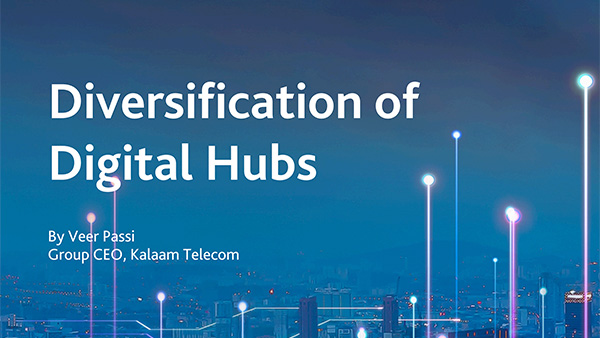The Middle East and North Africa (MENA) region has emerged as a center of digital innovation, with various hubs striving to become the go-to destinations for carriers, hyperscalers, and content players. However, as the region diversifies, it is crucial for market participants to develop a multi-market connectivity strategy that leverages the unique advantages offered by different hubs. Explore the changing dynamics of the MENA region, the importance of seamless cross-border connectivity, and the role of strategic partnerships in driving digital transformation.
Tapping Into The Growing Digital Transformation Market
aGovernments across the MENA region have launched digital transformation strategies that are boosting local digital infrastructure development while encouraging digital innovation. In September 2023, Bahrain’s government approved a digital economy sector strategy, building on Bahrain’s leadership in cloud-first strategies that were implemented more than five years ago.
Bahrain Economic Development Board attracted $295 million in direct investments within the ICT sector as part of a total projected direct investment worth $1.4 billion, during the first nine months of 2023. Similarly, the Dubai Chamber of Commerce released a report estimating that the UAE’s national digital economy will grow from $38 billion to over $140 billion by 2031. Public cloud regions are popping up across a range of markets and destinations with Amazon Web Services, Alibaba, Microsoft and Oracle all growing their presence in the region.
The digital transformation market in MENA is expected to rise from $38.4 billion in 2022 to $298.2 billion in 2032, according to Future Market Insights. The rise in remote working, driven by the pandemic, has accelerated global digitalization while advances in technology have transformed end-user industries such as healthcare, IT and telecoms. Carriers, and in turn, their enterprise customers want to rollout applications and services with the same user experience and performance across the entire region. When they can do that, they gain an immediate competitive advantage and can move with greater agility when delivering their digital strategies. Digitalization is rapidly expanding across the MENA region, providing carriers with a golden opportunity to drive growth in these new markets.
The Need For A Unified Approach
Unlike previous years, being present in a single hub is no longer sufficient. To effectively serve the region and gain a competitive advantage, carriers must ensure a consistent user experience and performance across the entire MENA region. The next decade will witness the decentralization of the region, emphasizing the importance of seamless cross-border connectivity. Carriers that can offer unified, multi-market connectivity will emerge as critical enablers for digital transformation.
Overcoming Challenges Through Strategic Partnerships
To expand their presence rapidly and efficiently across the Middle East, carriers face significant challenges. Customer expectations for improved connectivity have skyrocketed, while each market in the MENA region has its own unique regulations and business practices. Diversifying with a multi-market approach is key to meeting growing customer demands while conforming to local regulations.
Streamlining Network Expansion With Cloud Connectivity
Cloud connectivity provides carriers with a cost-effective and efficient solution for network expansion. By leveraging a cloud network and partnering with a one-stop-shop provider, carriers can bypass the need for on-premises hardware investments, saving resources that can be redirected to other growth channels. Additionally, cloud connectivity eliminates the need for negotiating individual deals with each country, accelerating the process of achieving pan-regional connectivity.
The Power Of A Comprehensive Configure, Price, Quote (CPQ) Platform Towards Digitizing The Wholesale Ecosystem
To cover the entire customer journey and streamline operational processes, carriers can leverage a partner with a comprehensive CPQ platform. An API-based CPQ platform offers dynamic pricing, real-time inventory management, and automated billing workflows, driving significant efficiencies in the quoting process and optimizing operations across the board.
This eliminates the need for manual data entry and enables real-time information sharing across various departments, enhancing overall operational efficiency. As carriers evolve and grow, a CPQ platform can scale and adapt to changing business needs. It can handle increasing quote volumes, support new product offerings, and accommodate pricing changes or promotions. The platform’s flexibility allows carriers to customize workflows, pricing rules, and user interfaces to align with their specific requirements. This enables carriers to enhance their agility and responsiveness, supporting their digital transformation initiatives.
Seizing The Opportunity: Accelerating Access In 2024
As we enter 2024, the MENA digital landscape presents abundant opportunities. Carriers must move beyond a single presence and seamlessly connect customers across the Middle East as the new standard. By partnering with the right provider, this goal becomes more achievable than ever. Embracing de-centralization and establishing digital hubs across the globe will allow organizations to grow on a global scale. The time to act is now.
The MENA region is witnessing a remarkable digital transformation journey, presenting carriers with immense potential for growth. To capitalize on this opportunity, a unified approach to network expansion is crucial. By leveraging strategic partnerships, cloud connectivity, and comprehensive CPQ platforms, carriers can overcome challenges, streamline operations, and provide a seamless digital experience across the region. Embracing these strategies will empower carriers to become critical enablers of digital transformation in the MENA region and beyond.
Blog
